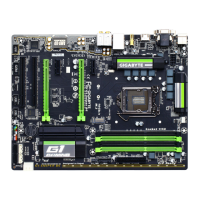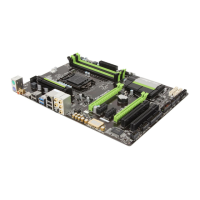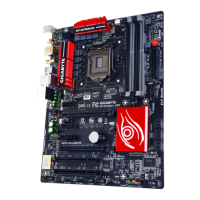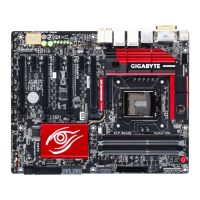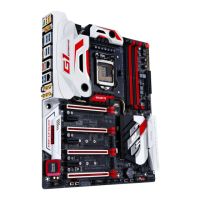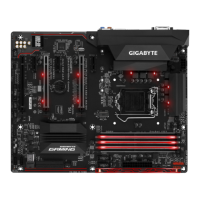- 21 - Hardware Installation
HDMI Port
HDMI (High-Denition Multimedia Interface) is an all-digital audio/video interface capable of transmitting
uncompressed audio/video signals. The HDMI port is HDCP compliant and supports Dolby TrueHD and
DTS HDMaster Audio formats. It also supports up to 192KHz/24bit 8-channel LPCM audio output. You can
use this port to connect your HDMI-supported monitor. The maximum supported resolution is 1920x1200,
but the actual resolutions supported are dependent on the monitor being used.
eSATA 3Gb/s Port
The eSATA 3Gb/s port conforms to SATA 3Gb/s standard and is compatible with SATA 1.5Gb/s standard.
Use the port to connect an external SATA device. The Intel Z77 Chipset supports RAID function. Refer to
Chapter 5, "Conguring SATA Hard Drive(s)," for instructions on conguring a RAID array.
RJ-45 LAN Port
The Gigabit Ethernet LAN port provides Internet connection at up to 1 Gbps data rate. The following
describes the states of the LAN port LEDs.
In Windows 7, select Start>Control Panel>Hardware and
Sound>Sound>Playback, set Intel(R) Display Audio to the
default playback device.
After installing the HDMI device, make sure to set the default sound playback device to HDMI.
(The item name may differ depending on your operating system. The screenshot below is from
Windows 7.)
Activity LED
Connection/
Speed LED
LAN Port
Activity LED:
Connection/Speed LED:
State Description
Orange 1 Gbps data rate
Green 100 Mbps data rate
Off 10 Mbps data rate
State Description
Blinking Data transmission or receiving is occurring
On No data transmission or receiving is occurring
USB 3.0/2.0 Port
The USB 3.0 port supports the USB 3.0 specication and is compatible to the USB 2.0/1.1 specication.
Use this port for USB devices such as a USB keyboard/mouse, USB printer, USB ash drive and etc.
Dual Display Congurations for the Onboard Graphics:
This motherboard provides four video output ports: D-Sub, DVI-D, HDMI, and DisplayPort. Dual monitor
confgurations are supported in operating system environment only, but not during the BIOS Setup or
POST process.

